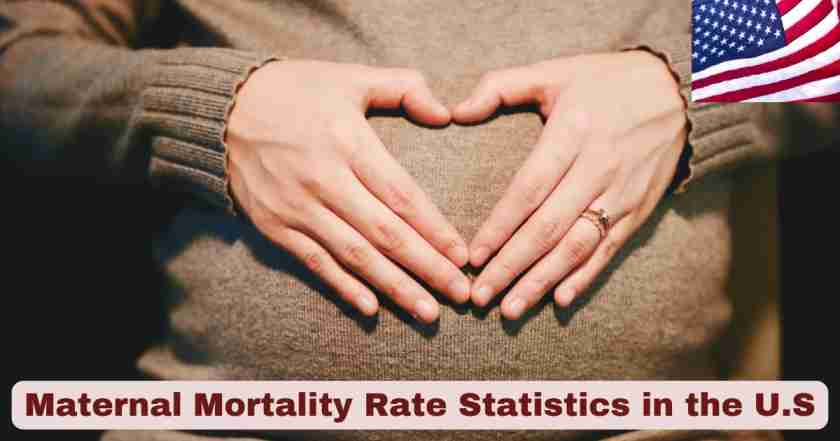Maternal Mortality Rates in the U.S. 2025
Maternal mortality remains a critical public health issue in the United States, with far-reaching implications for families, healthcare systems, and society at large. Despite advancements in medical technology and maternal care protocols, the U.S. continues to record significantly higher maternal death rates than other high-income countries. The 2023 maternal mortality rate of 18.6 deaths per 100,000 live births, though improved from pandemic-era highs, underscores ongoing challenges in safeguarding maternal health—especially for vulnerable populations. These statistics are more than just numbers; they represent real lives lost, often from preventable causes and within a healthcare system that too often fails its most at-risk patients.
The U.S. maternal health crisis is deeply intertwined with issues of racial disparity, age-related risks, geographic inequalities, and systemic healthcare failures. Black women, for example, face a maternal death rate 3.5 times higher than white women, regardless of income or education. Older mothers and those living in the South also face disproportionate risks due to limited access to care and persistent socioeconomic barriers. While recent initiatives—including extended postpartum Medicaid coverage, perinatal quality collaboratives, and maternal mortality review committees—are showing signs of progress, the road to reducing maternal deaths and eliminating disparities will require sustained commitment, policy reform, and equitable healthcare investment across all levels.
Key Facts About Maternal Mortality in the U.S.
| Maternal Mortality Key Facts | 2023 Data |
|---|---|
| Total Maternal Deaths | 669 women |
| Overall Maternal Mortality Rate | 18.6 deaths per 100,000 live births |
| Percentage Decrease from 2022 | 16.6% reduction |
| Black Women’s Mortality Rate | 50.3 deaths per 100,000 live births |
| White Women’s Mortality Rate | 14.5 deaths per 100,000 live births |
| Hispanic Women’s Mortality Rate | 12.4 deaths per 100,000 live births |
| Asian Women’s Mortality Rate | 10.7 deaths per 100,000 live births |
| Highest Risk Age Group | Women 40 and older: 59.8 deaths per 100,000 |
| Lowest Risk Age Group | Women under 25: 12.5 deaths per 100,000 |
| Racial Disparity Factor | Black women 3.5 times more likely to die than white women |
The maternal mortality landscape in the United States reveals both progress and persistent challenges that require urgent attention. The 2023 statistics represent a significant improvement from the pandemic peak, yet the numbers still reflect a healthcare system struggling to protect all mothers equally. These key facts highlight the complexity of maternal health outcomes and the multifaceted approach needed to address this crisis.
Understanding these statistics goes beyond mere numbers; they represent real women, families, and communities affected by preventable deaths. The data emphasizes that maternal mortality is not just a medical issue but a social justice concern that intersects with race, age, and access to quality healthcare. Every statistic represents a life that could have been saved with proper care and systemic improvements.
Overall Maternal Mortality Trends in the U.S. 2018-2023
| Year | Total Deaths | Mortality Rate (per 100,000 live births) | Live Births |
|---|---|---|---|
| 2018 | 658 | 17.4 | 3,791,712 |
| 2019 | 754 | 20.1 | 3,747,540 |
| 2020 | 861 | 23.8 | 3,613,647 |
| 2021 | 1,205 | 32.9 | 3,664,292 |
| 2022 | 817 | 22.3 | 3,667,758 |
| 2023 | 669 | 18.6 | 3,596,017 |
The six-year trend analysis reveals a concerning pattern that peaked during the COVID-19 pandemic in 2021 with the highest maternal mortality rate of 32.9 deaths per 100,000 live births. This represents a dramatic 89% increase from the 2018 baseline of 17.4 deaths per 100,000 live births. The 2021 spike included 1,205 maternal deaths, marking the most devastating year for maternal health in recent decades.
However, the 2022 and 2023 data show encouraging recovery, with mortality rates declining to 22.3 and 18.6 respectively. This improvement suggests that targeted interventions and healthcare system adaptations may be having a positive impact. The 2023 rate of 18.6 actually represents the lowest maternal mortality rate since 2018, indicating that progress is possible when healthcare systems prioritize maternal health outcomes and implement evidence-based practices.
Racial and Ethnic Disparities in Maternal Mortality in the U.S. 2023
| Race/Ethnicity | Deaths | Mortality Rate (per 100,000) | Live Births |
|---|---|---|---|
| Black, Non-Hispanic | 247 | 50.3 | 491,494 |
| White, Non-Hispanic | 259 | 14.5 | 1,787,051 |
| Hispanic | 117 | 12.4 | 945,200 |
| Asian, Non-Hispanic | 23 | 10.7 | 215,738 |
The racial disparities in maternal mortality represent one of the most troubling aspects of America’s maternal health crisis. Black women face a maternal mortality rate of 50.3 deaths per 100,000 live births, which is 3.5 times higher than white women and 4.7 times higher than Asian women. This disparity persists across all educational and income levels, indicating that systemic racism and bias in healthcare delivery contribute significantly to these outcomes.
Despite representing only 13.7% of all live births, Black women account for 36.9% of all maternal deaths in 2023. This disproportionate burden reflects decades of inadequate healthcare access, implicit bias in medical treatment, and social determinants of health that affect Black communities. The consistency of these disparities across different years suggests that addressing this crisis requires comprehensive systemic changes rather than isolated interventions.
Age-Related Maternal Mortality Patterns in the U.S. 2023
| Age Group | Deaths | Mortality Rate (per 100,000) | Live Births |
|---|---|---|---|
| Under 25 | 95 | 12.5 | 759,713 |
| 25-39 | 486 | 18.1 | 2,689,250 |
| 40 and Older | 88 | 59.8 | 147,054 |
Age represents a significant risk factor for maternal mortality, with women aged 40 and older facing nearly five times the risk of maternal death compared to younger mothers. The 59.8 deaths per 100,000 live births in the 40+ age group reflects the increased medical complexity and pregnancy-related complications that can occur with advanced maternal age.
The 25-39 age group, which represents the largest proportion of births at 74.8% of all live births, maintains a moderate risk level of 18.1 deaths per 100,000. However, this group accounts for 72.6% of all maternal deaths, highlighting the importance of high-quality obstetric care for women in their prime reproductive years. The relatively lower risk for women under 25 may reflect fewer underlying health conditions, though this group still faces significant challenges related to healthcare access and social support.
Historical Context and Pandemic Impact in the U.S. 2018-2023
| Period | Average Deaths | Average Rate | Key Characteristics |
|---|---|---|---|
| Pre-Pandemic (2018-2019) | 706 | 18.8 | Baseline Period |
| Early Pandemic (2020) | 861 | 23.8 | 26.6% Increase |
| Peak Pandemic (2021) | 1,205 | 32.9 | 75% Increase from Baseline |
| Recovery Period (2022-2023) | 743 | 20.5 | Declining but Above Baseline |
The COVID-19 pandemic fundamentally altered maternal health outcomes in the United States, creating unprecedented challenges for pregnant women and healthcare systems. The 2021 peak of 32.9 deaths per 100,000 live births represents a 75% increase from the pre-pandemic baseline, demonstrating how public health emergencies can disproportionately affect vulnerable populations.
Multiple factors contributed to this pandemic surge, including delayed prenatal care, overwhelmed healthcare systems, increased pregnancy complications from COVID-19 infection, and reduced access to specialized maternal care. The recovery period of 2022-2023 shows promising trends, with rates declining to 20.5 deaths per 100,000 on average, though still remaining 9% above pre-pandemic levels. This suggests that while immediate pandemic effects may be subsiding, longer-term impacts on maternal health systems continue to influence outcomes.
International Comparisons and U.S. Performance in 2023
| Country | Maternal Mortality Rate | Healthcare System Type | Comparison to U.S. |
|---|---|---|---|
| United States | 18.6 | Private/Mixed | Baseline |
| United Kingdom | 7.2 | Public | 2.6 times lower |
| Germany | 4.2 | Public | 4.4 times lower |
| Canada | 8.6 | Public | 2.2 times lower |
| France | 5.9 | Public | 3.2 times lower |
| Australia | 5.5 | Public | 3.4 times lower |
The United States continues to significantly underperform compared to other developed nations in maternal mortality outcomes. With a 2023 rate of 18.6 deaths per 100,000 live births, the U.S. maternal mortality rate is 2.2 to 4.4 times higher than other wealthy countries. This gap persists despite the United States spending more per capita on healthcare than any other nation.
The consistent pattern of better outcomes in countries with universal healthcare systems suggests that healthcare access and continuity of care play crucial roles in maternal health outcomes. Countries like Germany and France, with comprehensive prenatal care systems and universal access, achieve maternal mortality rates below 6 deaths per 100,000 live births. This international comparison highlights the potential for dramatic improvement in U.S. maternal health outcomes with appropriate policy changes and healthcare system reforms.
Preventability and Contributing Factors in the U.S. 2023
| Contributing Factor | Percentage of Deaths | Key Characteristics |
|---|---|---|
| Preventable Deaths | Over 80% | Could have been avoided with proper care |
| Cardiovascular Conditions | 33.5% | Leading cause of maternal death |
| Infection/Sepsis | 12.8% | Often preventable with timely care |
| Hemorrhage | 11.2% | Requires immediate medical response |
| Hypertensive Disorders | 9.3% | Manageable with proper monitoring |
| Pulmonary Embolism | 7.8% | Preventable with risk assessment |
The most striking aspect of maternal mortality statistics is that over 80% of these deaths are preventable according to maternal mortality review committees. This means that with proper healthcare access, quality care, and timely interventions, the vast majority of the 669 women who died in 2023 could have survived their pregnancies.
Cardiovascular conditions emerge as the leading cause of maternal death, accounting for 33.5% of all fatalities. This includes conditions like cardiomyopathy, congenital heart disease, and other cardiac complications that can be exacerbated by pregnancy. The high percentage of preventable deaths in this category underscores the importance of comprehensive preconception counseling and cardiac risk assessment for pregnant women. Similarly, infection and sepsis, hemorrhage, and hypertensive disorders represent manageable conditions that become fatal when healthcare systems fail to provide timely, appropriate care.
Geographic Variations in Maternal Mortality Across the U.S. 2023
| Region | Estimated Rate Range | Key Characteristics |
|---|---|---|
| Southern States | 25-35 per 100,000 | Highest rates, limited healthcare access |
| Southeastern States | 20-30 per 100,000 | Above national average |
| Northeastern States | 12-18 per 100,000 | Better healthcare infrastructure |
| Western States | 15-22 per 100,000 | Variable by state |
| Midwestern States | 16-24 per 100,000 | Mixed outcomes |
Geographic disparities in maternal mortality reveal significant regional variations that correlate with healthcare infrastructure, Medicaid expansion status, and social determinants of health. Southern states consistently report the highest maternal mortality rates, often 50-100% above the national average. This pattern reflects limited healthcare access, higher poverty rates, and lower rates of Medicaid expansion in many southern states.
States in the Northeast and West Coast generally achieve better outcomes, with rates closer to or below the national average of 18.6 deaths per 100,000 live births. These regions typically have better healthcare infrastructure, higher rates of insurance coverage, and more comprehensive maternal health programs. The geographic variations highlight how policy decisions at the state level, particularly regarding Medicaid expansion and healthcare funding, directly impact maternal health outcomes and contribute to preventable deaths.
Healthcare System Responses and Improvements in the U.S. 2023
| Intervention Type | Implementation Status | Expected Impact |
|---|---|---|
| Maternal Mortality Review Committees | Active in 48 states | Identifying preventable deaths |
| Perinatal Quality Collaboratives | Expanding nationwide | Standardizing care protocols |
| Telehealth Services | Rapidly expanding | Improving access to care |
| Medicaid Postpartum Extension | Adopted by 38 states | Extended coverage to 12 months |
| Maternal Early Warning Systems | Implemented in major hospitals | Early detection of complications |
| Implicit Bias Training | Pilot programs expanding | Addressing racial disparities |
The healthcare system’s response to the maternal mortality crisis has accelerated significantly, with multiple evidence-based interventions showing promise for improving outcomes. Maternal Mortality Review Committees now operate in 48 states, systematically analyzing each maternal death to identify opportunities for prevention and system improvements. These committees have been instrumental in revealing that over 80% of maternal deaths are preventable.
Medicaid postpartum coverage extension represents one of the most significant policy changes, with 38 states now providing coverage for 12 months postpartum rather than the previous 60 days. This extension addresses the fact that many maternal deaths occur weeks or months after delivery, when women may lose insurance coverage. The expansion of telehealth services has also improved access to prenatal care, particularly for women in rural areas who previously faced geographic barriers to receiving specialized obstetric care.
Future Projections and Goals for Maternal Mortality in the U.S. 2025
| Target | Current Rate (2023) | Goal by 2030 | Required Reduction |
|---|---|---|---|
| Overall Maternal Mortality | 18.6 per 100,000 | 12.0 per 100,000 | 35% reduction |
| Black Women’s Rate | 50.3 per 100,000 | 25.0 per 100,000 | 50% reduction |
| Preventable Deaths | 80% | 60% | 25% improvement |
| Geographic Disparities | 3-fold variation | 2-fold variation | Reduced variation |
The path forward for maternal mortality reduction requires ambitious but achievable goals that address both overall rates and persistent disparities. Reducing the overall maternal mortality rate to 12.0 deaths per 100,000 live births by 2030 would align the United States more closely with international standards while still recognizing the challenges of the current healthcare system.
Achieving a 50% reduction in maternal mortality for Black women represents the most critical goal, requiring targeted interventions that address structural racism, improve healthcare access, and ensure quality care delivery. This would reduce the Black maternal mortality rate from 50.3 to 25.0 deaths per 100,000 live births, though it would still remain above the current national average, highlighting the magnitude of existing disparities. Success in meeting these goals will require sustained commitment from healthcare systems, policymakers, and communities working together to prioritize maternal health and implement evidence-based solutions.
Disclaimer: The data research report we present here is based on information found from various sources. We are not liable for any financial loss, errors, or damages of any kind that may result from the use of the information herein. We acknowledge that though we try to report accurately, we cannot verify the absolute facts of everything that has been represented.







